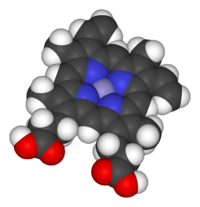
Photo from wikipedia
Peptides are not only useful models for the structural understanding of protein folding and stability but also provide promising therapeutic avenues for the treatment of numerous diseases, and as biomaterials.… Click to show full abstract
Peptides are not only useful models for the structural understanding of protein folding and stability but also provide promising therapeutic avenues for the treatment of numerous diseases, and as biomaterials. The field has been very active over the last decades, but the complex conformational behaviour of peptides still poses challenges to the characterisation and rational design of defined structures. In this context, we aim to provide a comprehensive overview of linear water-soluble monomeric peptides able to form the two simplest structural motifs: α-helices and β-hairpins. For both structures, we describe the geometry features, and the main contributions to stability: intrinsic propensities, position dependence of specific residues, particular capping motifs and side chain interactions. They should be considered to design α-helical or β-hairpin peptides. Solvent influence on peptide stability and selected in silico design approaches are also discussed. Moreover, we provide guidelines for structural characterisation of α-helical and β-hairpin-forming peptides by NMR and circular dichroism. We also highlight recently reported designed peptides and current strategies developed to improve their stability, bioactivity and bioavailability. The information gathered herein may aid peptide design and characterisation of stable α-helical and β-hairpin motifs in the search of biological constructs or improved peptide therapeutics.
Journal Title: Archives of biochemistry and biophysics
Year Published: 2019
Link to full text (if available)
Share on Social Media: Sign Up to like & get
recommendations!